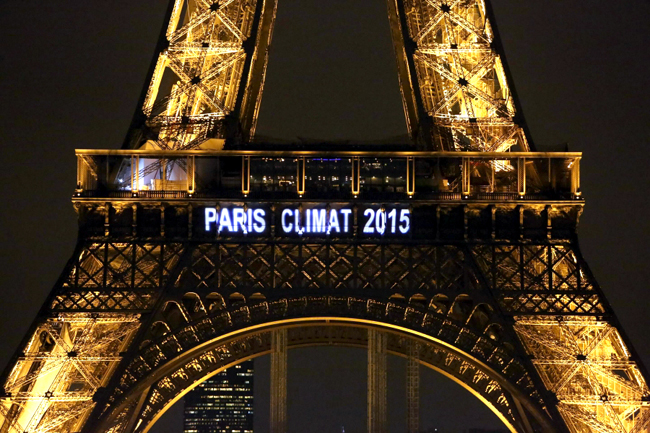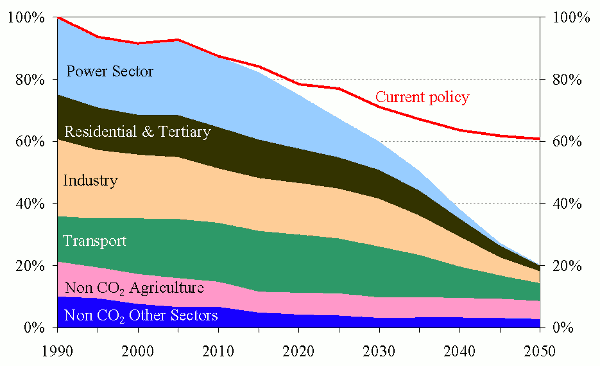April 1, 2015 – For the naysayers who are convinced that we cannot end our addiction to fossil fuels without destroying the world economy – April Fools! New analysis of pledges made preceding the upcoming United Nations Climate Summit in December of this year point to the opposite. So states the New Climate Institute in a new report.
The target, to limit global warming to 2 Celsius (3.6 Fahrenheit) degrees over and above the 0.85 Celsius (1.5 Fahrenheit) rise in temperature since 1880, could be achievable although some argue the merits of allowing this amount of wiggle room because of the negative impacts that rise will cause: stress to agricultural production, declining ocean food sources, ocean acidification and declining biodiversity, increasing freshwater scarcity and the disappearance of coastal communities as sea levels rise. These problems all of humanity will need to address as the century unfolds. But if the best we can do is limit the rise to 2 Celsius the report notes “massive health benefits” as well as a significant increase in global jobs.
Every country on the planet is being asked to pledge carbon emission reduction targets. The European Community’s 28 member states have promised a 40% reduction from 1990 to 2030. The net benefit, forecasted job growth of 70,000, 6,000 fewer pollution-related deaths, and a 33 billion saving in fossil fuel imports. Exceeding that target by another 15% would mean savings of 173 billion Euros with the creation of 420,000 jobs and 46,000 fewer deaths. But it doesn’t end there. The road map laid out by the European Commission (see chart below) sets an 80% reduction target by 2050.
The United States today intends to announce its own greenhouse gas target reductions, far less ambitious than Europe. The number is 28%, the same one that appeared in the November Chinese-U.S. joint strategy announcement on carbon reductions. Translated into other important statistics – it means 650,000 new full-time jobs and 27,000 avoided deaths.
Countries that have already announced target reductions before the first deadline which was today, April 1st, include Switzerland, Mexico and Norway. The Mexican announcement earlier this month pledged to cut emissions by 22%.
But among the principal polluters a number of countries have yet to announce targets. These include China, Russia, India, Canada, and Japan. And some countries, like Australia, have made interim announcements of sorts.
In Australia’s case the government has recently released a position paper on post-2020 emission reduction targets. The paper touts statistics that show emissions per capita have declined by 28% and per unit of gross domestic product by 52% since 1990. The economy and population in that same period have both nearly doubled. So using intensification reduction percentages is Australia’s way of dodging the fact that emissions have actually continued to grow. The actual Australian target for reductions by 2020 is a mere 5%, well below other nations. The anti-climate change government stresses the following reasons for its limited target – the economy needs its coal, natural gas and iron ore exports or there will be massive unemployment and a decline in per capita gross domestic product. As the New Climate Institute report suggests, this does not have to be the case.
China back in November came to agreement with the American executive branch to address greenhouse gas reductions. Where the United States pledged 28% as a reduction target, China only agreed to limit growth in CO2 emissions peaking by 2030 and declining thereafter. That’s hardly a reduction. At the same time China set a renewable energy goal in its production mix of 20% by 2030. China, like Australia, prefers to talk in terms of carbon intensity reductions per unit of gross domestic product. This, of course, is entirely misleading because it fails to account for the recent years of explosive economic growth in the country. And the proof today is in the numbers. The country is now the world’s largest emitter of carbon, ahead of the United States. Its cities are smog-filled. The average lifespan of its citizens is actually being shortened by the pollution. But should China implement greenhouse gas reduction strategies with the 2 degrees Celsius target, the New Climate Institute forecasts 2 million jobs created and one million lives saved.
The Canadian government, like Australia, uses obfuscation and misdirection to hide its abandonment of greenhouse gas reduction targets first set when the country signed the Kyoto Protocol. Canada was the first and only nation to withdraw from Kyoto and now speaks of greenhouse gas reductions by talking about emission intensity, not overall volume just like Australians and Chinese. We are still waiting for an announcement on reduction pledges for the forthcoming Paris meeting.
Japan, the country that hosted the Kyoto Protocol, and suffered through the Fukushima nuclear disaster in 2011, back in November 2013 pledged to reduce greenhouse gas emissions by 3.8% in 2020 from 2005 levels. This coming from the third or fourth largest economy in the world depending on who is compiling the statistics seems a poor effort. Formerly the country had committed to an 80% reduction in emissions by 2050 but at these current pledge levels it will require a fundamental shift in the energy mix including the use of the problematic nuclear option.
As Sharan Burrow, Secretary General of the International Trade Union Confederation, recently stated to The Guardian, “Our industries must face the challenge of massive decarbonization….we have the technology and there are millions of jobs possible from the necessary investment and millions more saved if we avoid the devastation of extreme climate change. There are no jobs on a dead planet.”
And as for the remaining countries in the world who have yet to submit their planned carbon reduction targets, all should be submitting them by no later than the end of summer. Then we will know if the 2 degrees Celsius target is viable. To read the details of the New Climate Institute Report published two days ago, access it by clicking on the link here.























[…] New Climate Institute details net benefits by country of limiting global warming to no more than 2 degrees Celsius. […]